Ethical Perspectives and Business Objectives: Nike Report
VerifiedAdded on 2020/02/05
|11
|4302
|340
Report
AI Summary
This report provides an in-depth analysis of the ethical considerations relevant to Nike, a global footwear and apparel corporation. It begins with an introduction to ethics, defining its role in business and outlining various theoretical ethical approaches such as teleological, deontological, emotive, moral-rights, and justice approaches. The report then compares and contrasts absolute and relative ethics, explaining their differences and implications. A significant portion of the report focuses on the ethical issues that impact Nike's operational activities, including low wages, poor working conditions, environmental damage, and discrimination. The report further explores how these ethical considerations affect Nike's business objectives, such as fair treatment of employees and sustainable production practices, and the implications for the business and its stakeholders. The report concludes by summarizing the key findings and emphasizing the importance of ethical practices in achieving business success and stakeholder satisfaction.

Ethical Perspectives
1
1
Paraphrase This Document
Need a fresh take? Get an instant paraphrase of this document with our AI Paraphraser
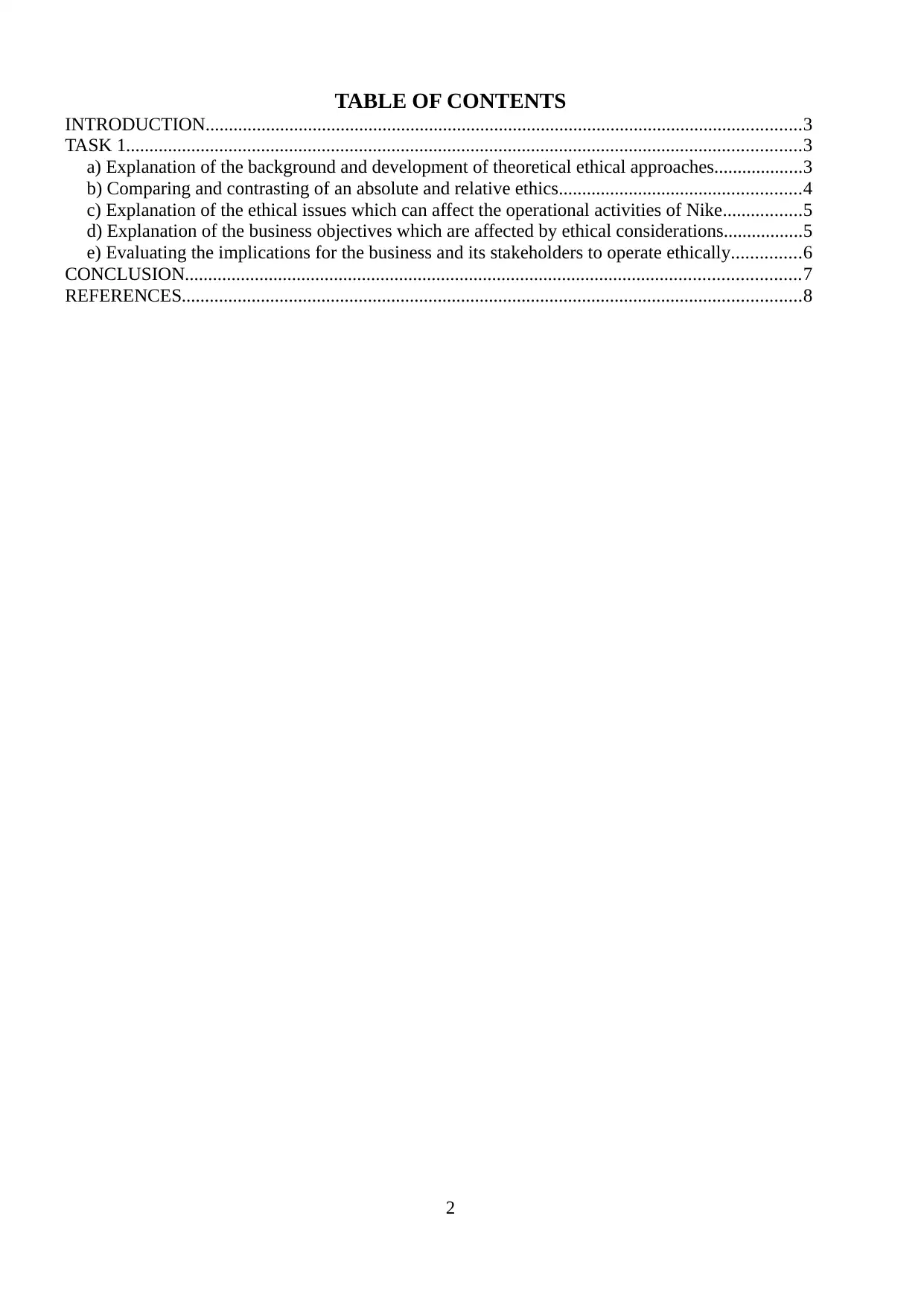
TABLE OF CONTENTS
INTRODUCTION................................................................................................................................3
TASK 1.................................................................................................................................................3
a) Explanation of the background and development of theoretical ethical approaches...................3
b) Comparing and contrasting of an absolute and relative ethics....................................................4
c) Explanation of the ethical issues which can affect the operational activities of Nike.................5
d) Explanation of the business objectives which are affected by ethical considerations.................5
e) Evaluating the implications for the business and its stakeholders to operate ethically...............6
CONCLUSION....................................................................................................................................7
REFERENCES.....................................................................................................................................8
2
INTRODUCTION................................................................................................................................3
TASK 1.................................................................................................................................................3
a) Explanation of the background and development of theoretical ethical approaches...................3
b) Comparing and contrasting of an absolute and relative ethics....................................................4
c) Explanation of the ethical issues which can affect the operational activities of Nike.................5
d) Explanation of the business objectives which are affected by ethical considerations.................5
e) Evaluating the implications for the business and its stakeholders to operate ethically...............6
CONCLUSION....................................................................................................................................7
REFERENCES.....................................................................................................................................8
2

INTRODUCTION
An area of study that deals with moral values which deals with the right and wrong and with
moral duty and obligation is known as ethics (Velasquez and et.al., 2015). Nike is an American
Multinational Corporation which designed, developed, produce, sells and markets the footwear
globally. The company also deals in apparel, equipment, accessories and services and also operates its
operation in the UK (Nike, 2016). For conducting the present research, report will cover the
background of ethical approaches and different ethical perspectives in operating business. It also
covers the business objectives from ethical perspectives for business and its stakeholders.
TASK 1
a) Explanation of the background and development of theoretical ethical approaches
Business ethics is an attribute which shows the framework in which business is formed and by
which business deals with other business. Different businesses have different ethics and it depend on
the way by which it is formed by the management. Business ethics can be summarized as standards and
principle which is guiding behaviour of people in business (Bakhtiyari and et.al., 2014). Some business
only consider of making profit whereas some business think of making profitability but it also think
about the customer satisfaction. Ethics is a set of moral principles that a business should follow and
values that a business should embraced in order for a business to be successful. There are different
types of theoretical ethical approaches and they are as following:1. Teleological approach: This approach is also known as consequentiality approach which
determines the moral conduct on the basis of the consequences of an activity (Jondle and et.al.,
2014). When an action is right or wrong is wholly depend on the consequences of such an
action. An act would be reasoned moral if it produced more satisfaction to the society than
dissatisfaction. The word teleology is derived from the Greek word 'telos' which means end or
purpose. This ethical theory argues the goal in the development of human mind to the fullest
possible potential (Sebastiani and et.al., 2013). This theory believes that actions are right if they
give happiness to people. For example, telling lie to the friend to give happiness to him. Deontological approach: When teleological approach is emphasis more on the welfare of the
society. On the other hand, deontological approach is focuses on the right thing which based on
moral principles. This approach is based on intrinsic good and bad in an act on which moral
judgements should be done. The word deontological is derived from the Greek word 'deon'
which means duty. This approach holds ethical decisions which has some moral principles
which does not think about the consequences (Lucas and et.al., 2015). Deontological approach
is duty based and action based which is known as humanitarian approach. For instance, one
3
An area of study that deals with moral values which deals with the right and wrong and with
moral duty and obligation is known as ethics (Velasquez and et.al., 2015). Nike is an American
Multinational Corporation which designed, developed, produce, sells and markets the footwear
globally. The company also deals in apparel, equipment, accessories and services and also operates its
operation in the UK (Nike, 2016). For conducting the present research, report will cover the
background of ethical approaches and different ethical perspectives in operating business. It also
covers the business objectives from ethical perspectives for business and its stakeholders.
TASK 1
a) Explanation of the background and development of theoretical ethical approaches
Business ethics is an attribute which shows the framework in which business is formed and by
which business deals with other business. Different businesses have different ethics and it depend on
the way by which it is formed by the management. Business ethics can be summarized as standards and
principle which is guiding behaviour of people in business (Bakhtiyari and et.al., 2014). Some business
only consider of making profit whereas some business think of making profitability but it also think
about the customer satisfaction. Ethics is a set of moral principles that a business should follow and
values that a business should embraced in order for a business to be successful. There are different
types of theoretical ethical approaches and they are as following:1. Teleological approach: This approach is also known as consequentiality approach which
determines the moral conduct on the basis of the consequences of an activity (Jondle and et.al.,
2014). When an action is right or wrong is wholly depend on the consequences of such an
action. An act would be reasoned moral if it produced more satisfaction to the society than
dissatisfaction. The word teleology is derived from the Greek word 'telos' which means end or
purpose. This ethical theory argues the goal in the development of human mind to the fullest
possible potential (Sebastiani and et.al., 2013). This theory believes that actions are right if they
give happiness to people. For example, telling lie to the friend to give happiness to him. Deontological approach: When teleological approach is emphasis more on the welfare of the
society. On the other hand, deontological approach is focuses on the right thing which based on
moral principles. This approach is based on intrinsic good and bad in an act on which moral
judgements should be done. The word deontological is derived from the Greek word 'deon'
which means duty. This approach holds ethical decisions which has some moral principles
which does not think about the consequences (Lucas and et.al., 2015). Deontological approach
is duty based and action based which is known as humanitarian approach. For instance, one
3
⊘ This is a preview!⊘
Do you want full access?
Subscribe today to unlock all pages.

Trusted by 1+ million students worldwide
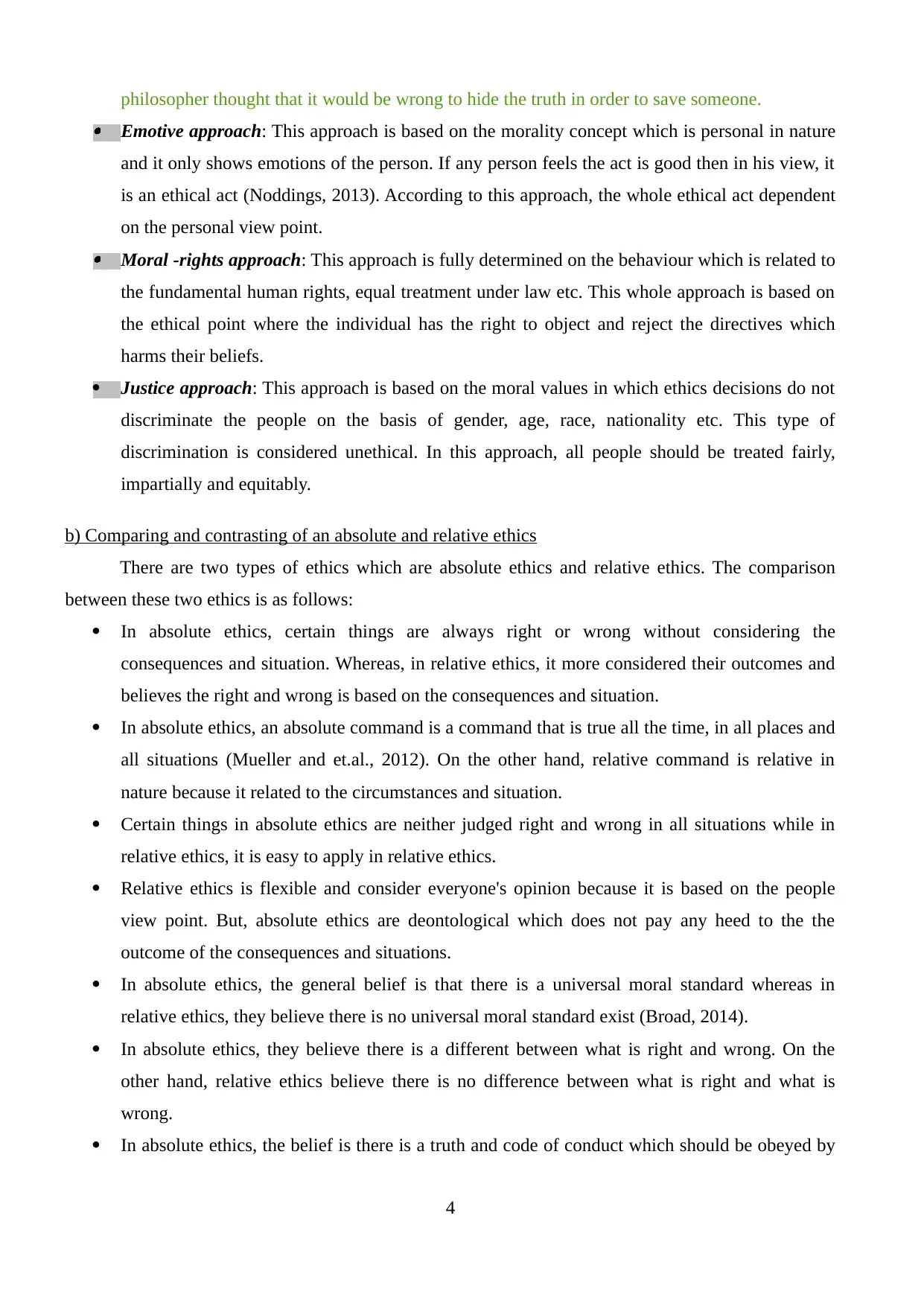
philosopher thought that it would be wrong to hide the truth in order to save someone. Emotive approach: This approach is based on the morality concept which is personal in nature
and it only shows emotions of the person. If any person feels the act is good then in his view, it
is an ethical act (Noddings, 2013). According to this approach, the whole ethical act dependent
on the personal view point. Moral -rights approach: This approach is fully determined on the behaviour which is related to
the fundamental human rights, equal treatment under law etc. This whole approach is based on
the ethical point where the individual has the right to object and reject the directives which
harms their beliefs.
Justice approach: This approach is based on the moral values in which ethics decisions do not
discriminate the people on the basis of gender, age, race, nationality etc. This type of
discrimination is considered unethical. In this approach, all people should be treated fairly,
impartially and equitably.
b) Comparing and contrasting of an absolute and relative ethics
There are two types of ethics which are absolute ethics and relative ethics. The comparison
between these two ethics is as follows:
In absolute ethics, certain things are always right or wrong without considering the
consequences and situation. Whereas, in relative ethics, it more considered their outcomes and
believes the right and wrong is based on the consequences and situation.
In absolute ethics, an absolute command is a command that is true all the time, in all places and
all situations (Mueller and et.al., 2012). On the other hand, relative command is relative in
nature because it related to the circumstances and situation.
Certain things in absolute ethics are neither judged right and wrong in all situations while in
relative ethics, it is easy to apply in relative ethics.
Relative ethics is flexible and consider everyone's opinion because it is based on the people
view point. But, absolute ethics are deontological which does not pay any heed to the the
outcome of the consequences and situations.
In absolute ethics, the general belief is that there is a universal moral standard whereas in
relative ethics, they believe there is no universal moral standard exist (Broad, 2014).
In absolute ethics, they believe there is a different between what is right and wrong. On the
other hand, relative ethics believe there is no difference between what is right and what is
wrong.
In absolute ethics, the belief is there is a truth and code of conduct which should be obeyed by
4
and it only shows emotions of the person. If any person feels the act is good then in his view, it
is an ethical act (Noddings, 2013). According to this approach, the whole ethical act dependent
on the personal view point. Moral -rights approach: This approach is fully determined on the behaviour which is related to
the fundamental human rights, equal treatment under law etc. This whole approach is based on
the ethical point where the individual has the right to object and reject the directives which
harms their beliefs.
Justice approach: This approach is based on the moral values in which ethics decisions do not
discriminate the people on the basis of gender, age, race, nationality etc. This type of
discrimination is considered unethical. In this approach, all people should be treated fairly,
impartially and equitably.
b) Comparing and contrasting of an absolute and relative ethics
There are two types of ethics which are absolute ethics and relative ethics. The comparison
between these two ethics is as follows:
In absolute ethics, certain things are always right or wrong without considering the
consequences and situation. Whereas, in relative ethics, it more considered their outcomes and
believes the right and wrong is based on the consequences and situation.
In absolute ethics, an absolute command is a command that is true all the time, in all places and
all situations (Mueller and et.al., 2012). On the other hand, relative command is relative in
nature because it related to the circumstances and situation.
Certain things in absolute ethics are neither judged right and wrong in all situations while in
relative ethics, it is easy to apply in relative ethics.
Relative ethics is flexible and consider everyone's opinion because it is based on the people
view point. But, absolute ethics are deontological which does not pay any heed to the the
outcome of the consequences and situations.
In absolute ethics, the general belief is that there is a universal moral standard whereas in
relative ethics, they believe there is no universal moral standard exist (Broad, 2014).
In absolute ethics, they believe there is a different between what is right and wrong. On the
other hand, relative ethics believe there is no difference between what is right and what is
wrong.
In absolute ethics, the belief is there is a truth and code of conduct which should be obeyed by
4
Paraphrase This Document
Need a fresh take? Get an instant paraphrase of this document with our AI Paraphraser
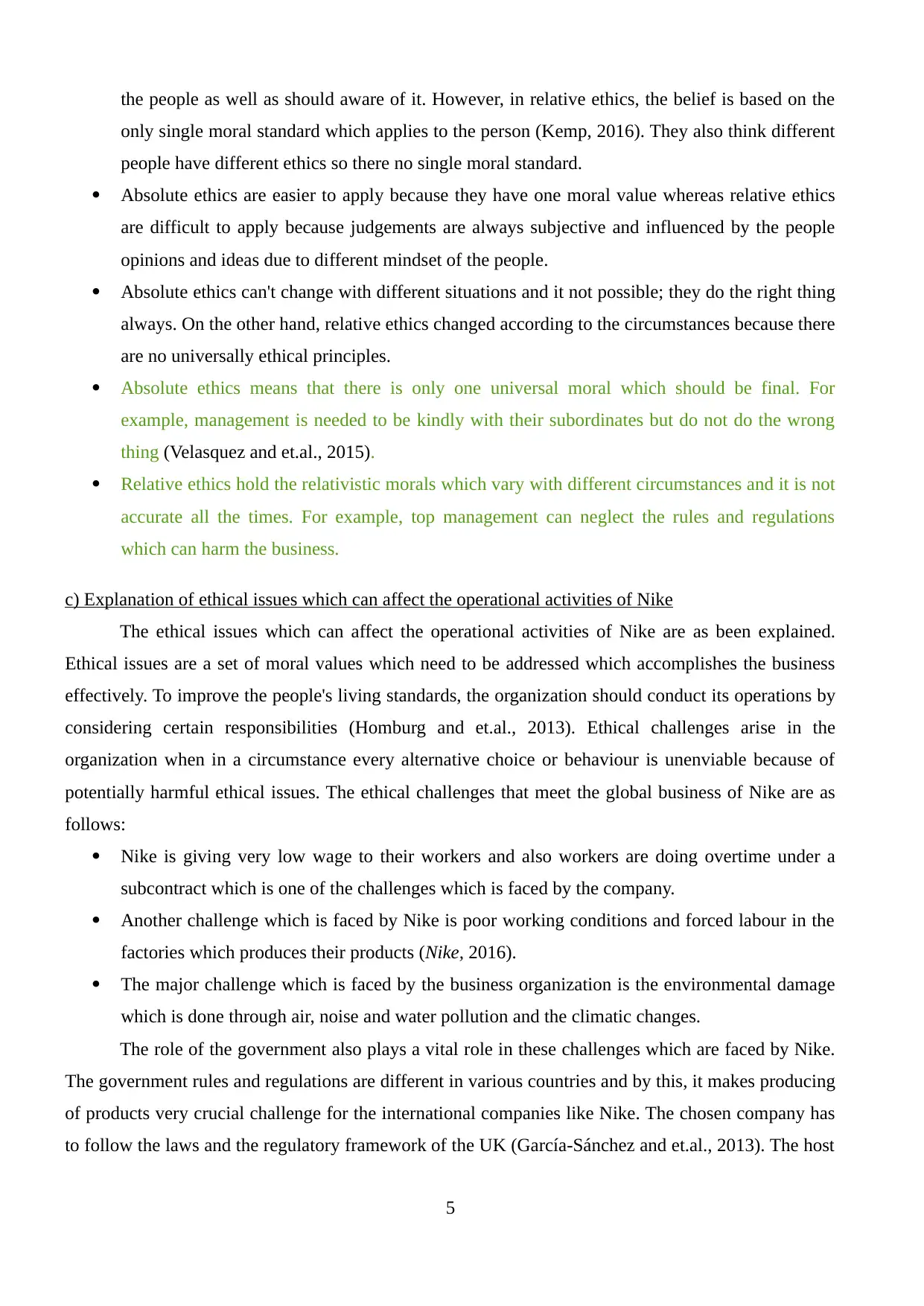
the people as well as should aware of it. However, in relative ethics, the belief is based on the
only single moral standard which applies to the person (Kemp, 2016). They also think different
people have different ethics so there no single moral standard.
Absolute ethics are easier to apply because they have one moral value whereas relative ethics
are difficult to apply because judgements are always subjective and influenced by the people
opinions and ideas due to different mindset of the people.
Absolute ethics can't change with different situations and it not possible; they do the right thing
always. On the other hand, relative ethics changed according to the circumstances because there
are no universally ethical principles.
Absolute ethics means that there is only one universal moral which should be final. For
example, management is needed to be kindly with their subordinates but do not do the wrong
thing (Velasquez and et.al., 2015).
Relative ethics hold the relativistic morals which vary with different circumstances and it is not
accurate all the times. For example, top management can neglect the rules and regulations
which can harm the business.
c) Explanation of ethical issues which can affect the operational activities of Nike
The ethical issues which can affect the operational activities of Nike are as been explained.
Ethical issues are a set of moral values which need to be addressed which accomplishes the business
effectively. To improve the people's living standards, the organization should conduct its operations by
considering certain responsibilities (Homburg and et.al., 2013). Ethical challenges arise in the
organization when in a circumstance every alternative choice or behaviour is unenviable because of
potentially harmful ethical issues. The ethical challenges that meet the global business of Nike are as
follows:
Nike is giving very low wage to their workers and also workers are doing overtime under a
subcontract which is one of the challenges which is faced by the company.
Another challenge which is faced by Nike is poor working conditions and forced labour in the
factories which produces their products (Nike, 2016).
The major challenge which is faced by the business organization is the environmental damage
which is done through air, noise and water pollution and the climatic changes.
The role of the government also plays a vital role in these challenges which are faced by Nike.
The government rules and regulations are different in various countries and by this, it makes producing
of products very crucial challenge for the international companies like Nike. The chosen company has
to follow the laws and the regulatory framework of the UK (García-Sánchez and et.al., 2013). The host
5
only single moral standard which applies to the person (Kemp, 2016). They also think different
people have different ethics so there no single moral standard.
Absolute ethics are easier to apply because they have one moral value whereas relative ethics
are difficult to apply because judgements are always subjective and influenced by the people
opinions and ideas due to different mindset of the people.
Absolute ethics can't change with different situations and it not possible; they do the right thing
always. On the other hand, relative ethics changed according to the circumstances because there
are no universally ethical principles.
Absolute ethics means that there is only one universal moral which should be final. For
example, management is needed to be kindly with their subordinates but do not do the wrong
thing (Velasquez and et.al., 2015).
Relative ethics hold the relativistic morals which vary with different circumstances and it is not
accurate all the times. For example, top management can neglect the rules and regulations
which can harm the business.
c) Explanation of ethical issues which can affect the operational activities of Nike
The ethical issues which can affect the operational activities of Nike are as been explained.
Ethical issues are a set of moral values which need to be addressed which accomplishes the business
effectively. To improve the people's living standards, the organization should conduct its operations by
considering certain responsibilities (Homburg and et.al., 2013). Ethical challenges arise in the
organization when in a circumstance every alternative choice or behaviour is unenviable because of
potentially harmful ethical issues. The ethical challenges that meet the global business of Nike are as
follows:
Nike is giving very low wage to their workers and also workers are doing overtime under a
subcontract which is one of the challenges which is faced by the company.
Another challenge which is faced by Nike is poor working conditions and forced labour in the
factories which produces their products (Nike, 2016).
The major challenge which is faced by the business organization is the environmental damage
which is done through air, noise and water pollution and the climatic changes.
The role of the government also plays a vital role in these challenges which are faced by Nike.
The government rules and regulations are different in various countries and by this, it makes producing
of products very crucial challenge for the international companies like Nike. The chosen company has
to follow the laws and the regulatory framework of the UK (García-Sánchez and et.al., 2013). The host
5

governments have laws considering against information and labelling, employment, wages and
salaries, consumer protection and regarding their health and safety of the workers. The most visible
changes in the legal political factors evolved and increase of international trade agreements and the
emergence of international trade alliance between different countries for instance, European union.
The ethical issue which is affecting the culture of organization and damaging the moral
motivation of employees can be discrimination issue. This issue plays a major role in the organization
which is creating discrimination between men and women. In this issue, inequality between men and
women is done through bullying in which old employees harass the new trainees (Noddings, 2013).
There is a difference in salaries which are given to employees on the basis of men and women.
The other ethical issues can be increasing of prices without valid reasons because taking
advantages of the customers is an ethical. The company should also refrain from doing any corrupt
practises for example, selling low quality products while bribing government officials. Somehow, the
false dealings and corruption will tarnish the image of the Nike and give negative impact on sales.
Other ethical issue includes marketing issues such as selling of goods and services which can harm the
environment (Zikmund and et.al., 2012). There are the products which are harmful to the environment
so they should be avoided by the manufacturer. These marketing issues can affect the environment as
well as the ethics of business.
d) Explanation of the business objectives which are affected by ethical considerations
To achieve the aims and objectives of the business, ethical considerations are to be needed.
Ethical considerations is very essential in organization when business are done on the moral values, the
business will be profitable and meet the expectation of its stakeholders. For example, there is a child
labour in the Nike of United Kingdom where the production plant is in America, the workers are paid
below the minimum wages and also subject to miserable working conditions. This is considered as
unethical because workers are being paid with minimum wages (Sebastiani and et.al., 2013).
According to the labour law, all the workers should be paid with equal wages and if the workers are
paid below the minimum wages is to be termed as unfair. Business decisions have to concern about
ethical considerations and if not then it will affect the business reputation to such an extent that Nike
have to exit the market. Other examples of business objectives which are affected by ethical
considerations were the sweatshops which are used by Nike. The sweatshops affect the environmental
policy, quality standards of company as well as the profitability and the market share (Mueller and
et.al., 2012). To overcome from these ethical issues, Nike has started CSR reports in which company
continues to post its commitments, standards and the audit data. Other business objectives of Nike
which are affected by ethical considerations are as follows:
6
salaries, consumer protection and regarding their health and safety of the workers. The most visible
changes in the legal political factors evolved and increase of international trade agreements and the
emergence of international trade alliance between different countries for instance, European union.
The ethical issue which is affecting the culture of organization and damaging the moral
motivation of employees can be discrimination issue. This issue plays a major role in the organization
which is creating discrimination between men and women. In this issue, inequality between men and
women is done through bullying in which old employees harass the new trainees (Noddings, 2013).
There is a difference in salaries which are given to employees on the basis of men and women.
The other ethical issues can be increasing of prices without valid reasons because taking
advantages of the customers is an ethical. The company should also refrain from doing any corrupt
practises for example, selling low quality products while bribing government officials. Somehow, the
false dealings and corruption will tarnish the image of the Nike and give negative impact on sales.
Other ethical issue includes marketing issues such as selling of goods and services which can harm the
environment (Zikmund and et.al., 2012). There are the products which are harmful to the environment
so they should be avoided by the manufacturer. These marketing issues can affect the environment as
well as the ethics of business.
d) Explanation of the business objectives which are affected by ethical considerations
To achieve the aims and objectives of the business, ethical considerations are to be needed.
Ethical considerations is very essential in organization when business are done on the moral values, the
business will be profitable and meet the expectation of its stakeholders. For example, there is a child
labour in the Nike of United Kingdom where the production plant is in America, the workers are paid
below the minimum wages and also subject to miserable working conditions. This is considered as
unethical because workers are being paid with minimum wages (Sebastiani and et.al., 2013).
According to the labour law, all the workers should be paid with equal wages and if the workers are
paid below the minimum wages is to be termed as unfair. Business decisions have to concern about
ethical considerations and if not then it will affect the business reputation to such an extent that Nike
have to exit the market. Other examples of business objectives which are affected by ethical
considerations were the sweatshops which are used by Nike. The sweatshops affect the environmental
policy, quality standards of company as well as the profitability and the market share (Mueller and
et.al., 2012). To overcome from these ethical issues, Nike has started CSR reports in which company
continues to post its commitments, standards and the audit data. Other business objectives of Nike
which are affected by ethical considerations are as follows:
6
⊘ This is a preview!⊘
Do you want full access?
Subscribe today to unlock all pages.

Trusted by 1+ million students worldwide
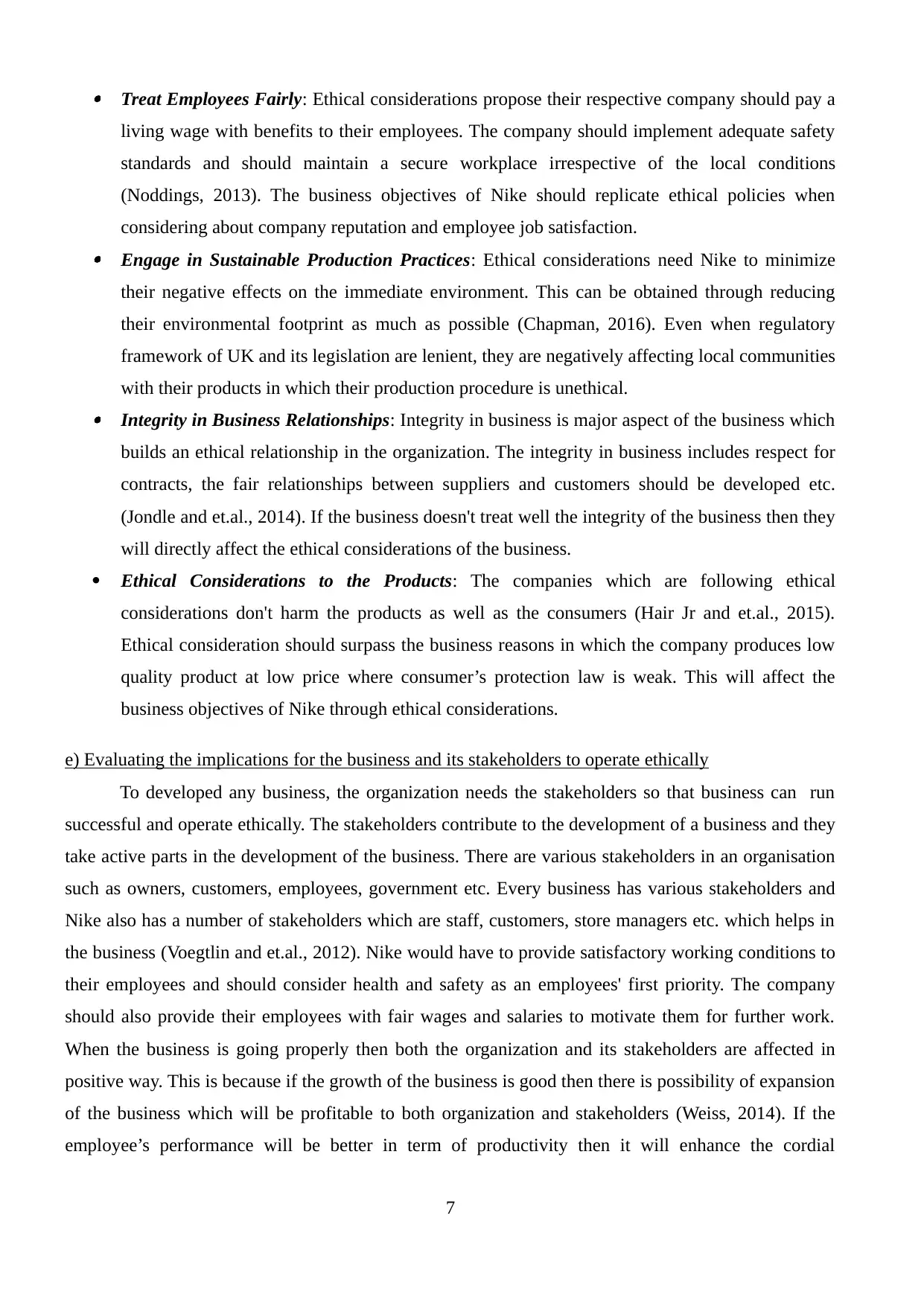
Treat Employees Fairly: Ethical considerations propose their respective company should pay a
living wage with benefits to their employees. The company should implement adequate safety
standards and should maintain a secure workplace irrespective of the local conditions
(Noddings, 2013). The business objectives of Nike should replicate ethical policies when
considering about company reputation and employee job satisfaction. Engage in Sustainable Production Practices: Ethical considerations need Nike to minimize
their negative effects on the immediate environment. This can be obtained through reducing
their environmental footprint as much as possible (Chapman, 2016). Even when regulatory
framework of UK and its legislation are lenient, they are negatively affecting local communities
with their products in which their production procedure is unethical. Integrity in Business Relationships: Integrity in business is major aspect of the business which
builds an ethical relationship in the organization. The integrity in business includes respect for
contracts, the fair relationships between suppliers and customers should be developed etc.
(Jondle and et.al., 2014). If the business doesn't treat well the integrity of the business then they
will directly affect the ethical considerations of the business.
Ethical Considerations to the Products: The companies which are following ethical
considerations don't harm the products as well as the consumers (Hair Jr and et.al., 2015).
Ethical consideration should surpass the business reasons in which the company produces low
quality product at low price where consumer’s protection law is weak. This will affect the
business objectives of Nike through ethical considerations.
e) Evaluating the implications for the business and its stakeholders to operate ethically
To developed any business, the organization needs the stakeholders so that business can run
successful and operate ethically. The stakeholders contribute to the development of a business and they
take active parts in the development of the business. There are various stakeholders in an organisation
such as owners, customers, employees, government etc. Every business has various stakeholders and
Nike also has a number of stakeholders which are staff, customers, store managers etc. which helps in
the business (Voegtlin and et.al., 2012). Nike would have to provide satisfactory working conditions to
their employees and should consider health and safety as an employees' first priority. The company
should also provide their employees with fair wages and salaries to motivate them for further work.
When the business is going properly then both the organization and its stakeholders are affected in
positive way. This is because if the growth of the business is good then there is possibility of expansion
of the business which will be profitable to both organization and stakeholders (Weiss, 2014). If the
employee’s performance will be better in term of productivity then it will enhance the cordial
7
living wage with benefits to their employees. The company should implement adequate safety
standards and should maintain a secure workplace irrespective of the local conditions
(Noddings, 2013). The business objectives of Nike should replicate ethical policies when
considering about company reputation and employee job satisfaction. Engage in Sustainable Production Practices: Ethical considerations need Nike to minimize
their negative effects on the immediate environment. This can be obtained through reducing
their environmental footprint as much as possible (Chapman, 2016). Even when regulatory
framework of UK and its legislation are lenient, they are negatively affecting local communities
with their products in which their production procedure is unethical. Integrity in Business Relationships: Integrity in business is major aspect of the business which
builds an ethical relationship in the organization. The integrity in business includes respect for
contracts, the fair relationships between suppliers and customers should be developed etc.
(Jondle and et.al., 2014). If the business doesn't treat well the integrity of the business then they
will directly affect the ethical considerations of the business.
Ethical Considerations to the Products: The companies which are following ethical
considerations don't harm the products as well as the consumers (Hair Jr and et.al., 2015).
Ethical consideration should surpass the business reasons in which the company produces low
quality product at low price where consumer’s protection law is weak. This will affect the
business objectives of Nike through ethical considerations.
e) Evaluating the implications for the business and its stakeholders to operate ethically
To developed any business, the organization needs the stakeholders so that business can run
successful and operate ethically. The stakeholders contribute to the development of a business and they
take active parts in the development of the business. There are various stakeholders in an organisation
such as owners, customers, employees, government etc. Every business has various stakeholders and
Nike also has a number of stakeholders which are staff, customers, store managers etc. which helps in
the business (Voegtlin and et.al., 2012). Nike would have to provide satisfactory working conditions to
their employees and should consider health and safety as an employees' first priority. The company
should also provide their employees with fair wages and salaries to motivate them for further work.
When the business is going properly then both the organization and its stakeholders are affected in
positive way. This is because if the growth of the business is good then there is possibility of expansion
of the business which will be profitable to both organization and stakeholders (Weiss, 2014). If the
employee’s performance will be better in term of productivity then it will enhance the cordial
7
Paraphrase This Document
Need a fresh take? Get an instant paraphrase of this document with our AI Paraphraser
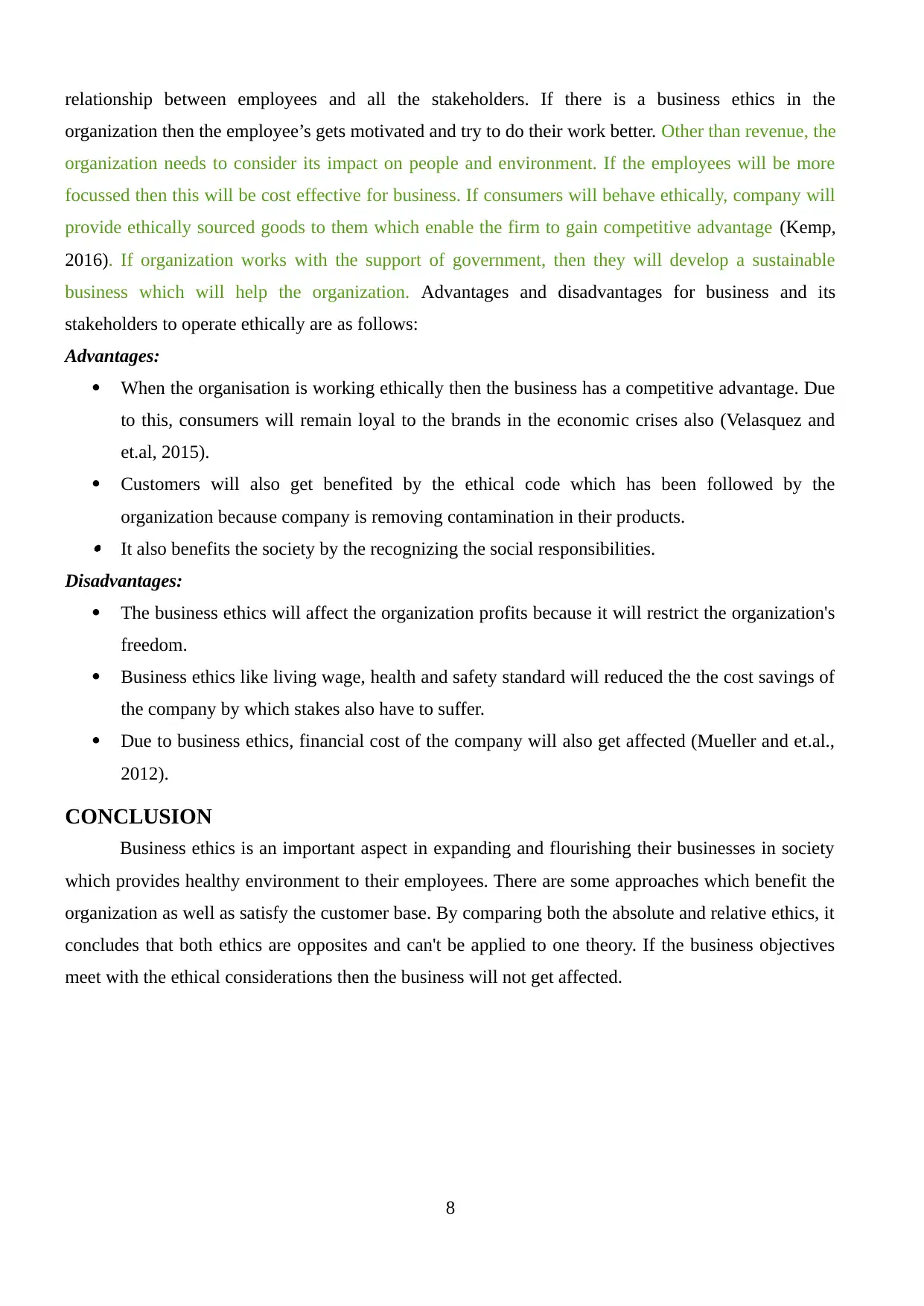
relationship between employees and all the stakeholders. If there is a business ethics in the
organization then the employee’s gets motivated and try to do their work better. Other than revenue, the
organization needs to consider its impact on people and environment. If the employees will be more
focussed then this will be cost effective for business. If consumers will behave ethically, company will
provide ethically sourced goods to them which enable the firm to gain competitive advantage (Kemp,
2016). If organization works with the support of government, then they will develop a sustainable
business which will help the organization. Advantages and disadvantages for business and its
stakeholders to operate ethically are as follows:
Advantages:
When the organisation is working ethically then the business has a competitive advantage. Due
to this, consumers will remain loyal to the brands in the economic crises also (Velasquez and
et.al, 2015).
Customers will also get benefited by the ethical code which has been followed by the
organization because company is removing contamination in their products. It also benefits the society by the recognizing the social responsibilities.
Disadvantages:
The business ethics will affect the organization profits because it will restrict the organization's
freedom.
Business ethics like living wage, health and safety standard will reduced the the cost savings of
the company by which stakes also have to suffer.
Due to business ethics, financial cost of the company will also get affected (Mueller and et.al.,
2012).
CONCLUSION
Business ethics is an important aspect in expanding and flourishing their businesses in society
which provides healthy environment to their employees. There are some approaches which benefit the
organization as well as satisfy the customer base. By comparing both the absolute and relative ethics, it
concludes that both ethics are opposites and can't be applied to one theory. If the business objectives
meet with the ethical considerations then the business will not get affected.
8
organization then the employee’s gets motivated and try to do their work better. Other than revenue, the
organization needs to consider its impact on people and environment. If the employees will be more
focussed then this will be cost effective for business. If consumers will behave ethically, company will
provide ethically sourced goods to them which enable the firm to gain competitive advantage (Kemp,
2016). If organization works with the support of government, then they will develop a sustainable
business which will help the organization. Advantages and disadvantages for business and its
stakeholders to operate ethically are as follows:
Advantages:
When the organisation is working ethically then the business has a competitive advantage. Due
to this, consumers will remain loyal to the brands in the economic crises also (Velasquez and
et.al, 2015).
Customers will also get benefited by the ethical code which has been followed by the
organization because company is removing contamination in their products. It also benefits the society by the recognizing the social responsibilities.
Disadvantages:
The business ethics will affect the organization profits because it will restrict the organization's
freedom.
Business ethics like living wage, health and safety standard will reduced the the cost savings of
the company by which stakes also have to suffer.
Due to business ethics, financial cost of the company will also get affected (Mueller and et.al.,
2012).
CONCLUSION
Business ethics is an important aspect in expanding and flourishing their businesses in society
which provides healthy environment to their employees. There are some approaches which benefit the
organization as well as satisfy the customer base. By comparing both the absolute and relative ethics, it
concludes that both ethics are opposites and can't be applied to one theory. If the business objectives
meet with the ethical considerations then the business will not get affected.
8
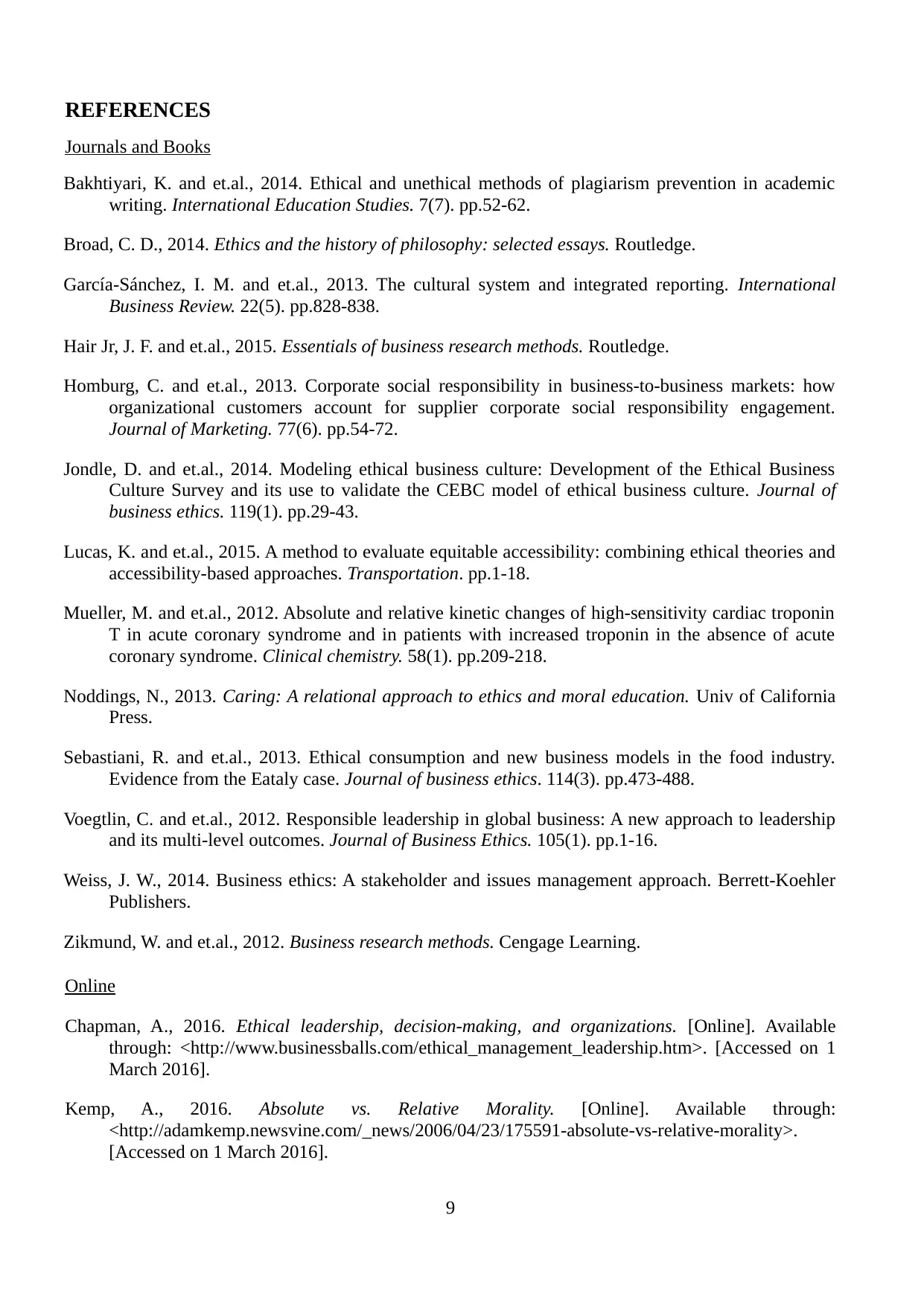
REFERENCES
Journals and Books
Bakhtiyari, K. and et.al., 2014. Ethical and unethical methods of plagiarism prevention in academic
writing. International Education Studies. 7(7). pp.52-62.
Broad, C. D., 2014. Ethics and the history of philosophy: selected essays. Routledge.
García-Sánchez, I. M. and et.al., 2013. The cultural system and integrated reporting. International
Business Review. 22(5). pp.828-838.
Hair Jr, J. F. and et.al., 2015. Essentials of business research methods. Routledge.
Homburg, C. and et.al., 2013. Corporate social responsibility in business-to-business markets: how
organizational customers account for supplier corporate social responsibility engagement.
Journal of Marketing. 77(6). pp.54-72.
Jondle, D. and et.al., 2014. Modeling ethical business culture: Development of the Ethical Business
Culture Survey and its use to validate the CEBC model of ethical business culture. Journal of
business ethics. 119(1). pp.29-43.
Lucas, K. and et.al., 2015. A method to evaluate equitable accessibility: combining ethical theories and
accessibility-based approaches. Transportation. pp.1-18.
Mueller, M. and et.al., 2012. Absolute and relative kinetic changes of high-sensitivity cardiac troponin
T in acute coronary syndrome and in patients with increased troponin in the absence of acute
coronary syndrome. Clinical chemistry. 58(1). pp.209-218.
Noddings, N., 2013. Caring: A relational approach to ethics and moral education. Univ of California
Press.
Sebastiani, R. and et.al., 2013. Ethical consumption and new business models in the food industry.
Evidence from the Eataly case. Journal of business ethics. 114(3). pp.473-488.
Voegtlin, C. and et.al., 2012. Responsible leadership in global business: A new approach to leadership
and its multi-level outcomes. Journal of Business Ethics. 105(1). pp.1-16.
Weiss, J. W., 2014. Business ethics: A stakeholder and issues management approach. Berrett-Koehler
Publishers.
Zikmund, W. and et.al., 2012. Business research methods. Cengage Learning.
Online
Chapman, A., 2016. Ethical leadership, decision-making, and organizations. [Online]. Available
through: <http://www.businessballs.com/ethical_management_leadership.htm>. [Accessed on 1
March 2016].
Kemp, A., 2016. Absolute vs. Relative Morality. [Online]. Available through:
<http://adamkemp.newsvine.com/_news/2006/04/23/175591-absolute-vs-relative-morality>.
[Accessed on 1 March 2016].
9
Journals and Books
Bakhtiyari, K. and et.al., 2014. Ethical and unethical methods of plagiarism prevention in academic
writing. International Education Studies. 7(7). pp.52-62.
Broad, C. D., 2014. Ethics and the history of philosophy: selected essays. Routledge.
García-Sánchez, I. M. and et.al., 2013. The cultural system and integrated reporting. International
Business Review. 22(5). pp.828-838.
Hair Jr, J. F. and et.al., 2015. Essentials of business research methods. Routledge.
Homburg, C. and et.al., 2013. Corporate social responsibility in business-to-business markets: how
organizational customers account for supplier corporate social responsibility engagement.
Journal of Marketing. 77(6). pp.54-72.
Jondle, D. and et.al., 2014. Modeling ethical business culture: Development of the Ethical Business
Culture Survey and its use to validate the CEBC model of ethical business culture. Journal of
business ethics. 119(1). pp.29-43.
Lucas, K. and et.al., 2015. A method to evaluate equitable accessibility: combining ethical theories and
accessibility-based approaches. Transportation. pp.1-18.
Mueller, M. and et.al., 2012. Absolute and relative kinetic changes of high-sensitivity cardiac troponin
T in acute coronary syndrome and in patients with increased troponin in the absence of acute
coronary syndrome. Clinical chemistry. 58(1). pp.209-218.
Noddings, N., 2013. Caring: A relational approach to ethics and moral education. Univ of California
Press.
Sebastiani, R. and et.al., 2013. Ethical consumption and new business models in the food industry.
Evidence from the Eataly case. Journal of business ethics. 114(3). pp.473-488.
Voegtlin, C. and et.al., 2012. Responsible leadership in global business: A new approach to leadership
and its multi-level outcomes. Journal of Business Ethics. 105(1). pp.1-16.
Weiss, J. W., 2014. Business ethics: A stakeholder and issues management approach. Berrett-Koehler
Publishers.
Zikmund, W. and et.al., 2012. Business research methods. Cengage Learning.
Online
Chapman, A., 2016. Ethical leadership, decision-making, and organizations. [Online]. Available
through: <http://www.businessballs.com/ethical_management_leadership.htm>. [Accessed on 1
March 2016].
Kemp, A., 2016. Absolute vs. Relative Morality. [Online]. Available through:
<http://adamkemp.newsvine.com/_news/2006/04/23/175591-absolute-vs-relative-morality>.
[Accessed on 1 March 2016].
9
⊘ This is a preview!⊘
Do you want full access?
Subscribe today to unlock all pages.

Trusted by 1+ million students worldwide

Nike. 2016. [Online]. Available through: <http://about.nike.com/pages/company-profile>. [Accessed on
1 March 2016].
Velasquez, M. and et.al, 2015. What is Ethics. [Online]. Available through:
<https://www.scu.edu/ethics/ethics-resources/ethical-decision-making/what-is-ethics/>.
[Accessed on 1 March 2016].
10
1 March 2016].
Velasquez, M. and et.al, 2015. What is Ethics. [Online]. Available through:
<https://www.scu.edu/ethics/ethics-resources/ethical-decision-making/what-is-ethics/>.
[Accessed on 1 March 2016].
10
Paraphrase This Document
Need a fresh take? Get an instant paraphrase of this document with our AI Paraphraser

Page | 11
1 out of 11
Related Documents
Your All-in-One AI-Powered Toolkit for Academic Success.
+13062052269
info@desklib.com
Available 24*7 on WhatsApp / Email
![[object Object]](/_next/static/media/star-bottom.7253800d.svg)
Unlock your academic potential
Copyright © 2020–2025 A2Z Services. All Rights Reserved. Developed and managed by ZUCOL.





